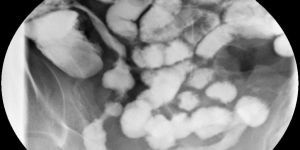Use of Imaging Technology to Determine Optimal Treatment for Crohn's
Ultrasound elasticity imaging could allow doctors to make the distinction between inflammation and fibrosis noninvasively.

Ultrasound elasticity imaging (UEI) could allow doctors to make the distinction between inflammation and fibrosis noninvasively, thus allowing patients to receive more appropriate and timely care for Crohn’s disease, according to a recent study.
The study, which was published recently in Gastroenterology, was conducted at the University of Michigan.
Crohn’s disease results in intestinal inflammation that is usually treated with medicines that suppress the immune system. Patients with fibrosis are treated surgically. Current diagnostic tests, including CT scans and MRIs, cannot detect the difference between the two conditions. As a result, many patients with fibrosis are often initially treated with immune system-suppressing drugs, which are expensive and are unlikely to help.
“These therapies are potent, costly and carry risk,” lead author Ryan Stidham, MD, clinical lecturer in the Department of Internal Medicine at U of M, said in a statement. “And for patients with fibrosis, such treatment might be for naught.”
Fibrotic tissue is hard and thick, and inflamed intestinal tissue is softer. UEI uses ultrasound to measure the relative hardness and thickness of tissue inside the body, potentially allowing doctors to differentiate between the two conditions without performing surgery. UEI was able to accurately tell the difference between inflamed tissue and scar tissue in animal models.
“The goal of this study is to have technology that can make the distinction between fibrosis and inflammation,” Stidham said. “We want to know if it’s worth it to push medical therapy, or if a person is destined for surgery.”
After developing the imaging technique in a rat model, the researchers also found that UEI was capable of differentiating between fibrotic and unaffected intestine in a pilot human study. Patients already scheduled for surgical treatment underwent UEI assessment prior to surgery, and fibrotic strictures were identified in each case.
The next step in the group’s research is a long-term human clinical trial. If UEI is able to accurately assess a patient’s condition, doctors will be able to more efficiently treat Crohn’s disease patients.
“UEI has great potential to provide a clear measurement that helps clinicians judge whether medical or surgical management is best for the individual patient earlier in their disease course,” Stidham said.
SourceImaging Technology Might Help Doctors Determine Best Treatment for Crohn’s Disease Patients [University of Michigan]